Mattia Rigotti
Risk Assessment and Statistical Significance in the Age of Foundation Models
Oct 11, 2023



Abstract:We propose a distributional framework for assessing socio-technical risks of foundation models with quantified statistical significance. Our approach hinges on a new statistical relative testing based on first and second order stochastic dominance of real random variables. We show that the second order statistics in this test are linked to mean-risk models commonly used in econometrics and mathematical finance to balance risk and utility when choosing between alternatives. Using this framework, we formally develop a risk-aware approach for foundation model selection given guardrails quantified by specified metrics. Inspired by portfolio optimization and selection theory in mathematical finance, we define a \emph{metrics portfolio} for each model as a means to aggregate a collection of metrics, and perform model selection based on the stochastic dominance of these portfolios. The statistical significance of our tests is backed theoretically by an asymptotic analysis via central limit theorems instantiated in practice via a bootstrap variance estimate. We use our framework to compare various large language models regarding risks related to drifting from instructions and outputting toxic content.
DARE: Towards Robust Text Explanations in Biomedical and Healthcare Applications
Jul 05, 2023Abstract:Along with the successful deployment of deep neural networks in several application domains, the need to unravel the black-box nature of these networks has seen a significant increase recently. Several methods have been introduced to provide insight into the inference process of deep neural networks. However, most of these explainability methods have been shown to be brittle in the face of adversarial perturbations of their inputs in the image and generic textual domain. In this work we show that this phenomenon extends to specific and important high stakes domains like biomedical datasets. In particular, we observe that the robustness of explanations should be characterized in terms of the accuracy of the explanation in linking a model's inputs and its decisions - faithfulness - and its relevance from the perspective of domain experts - plausibility. This is crucial to prevent explanations that are inaccurate but still look convincing in the context of the domain at hand. To this end, we show how to adapt current attribution robustness estimation methods to a given domain, so as to take into account domain-specific plausibility. This results in our DomainAdaptiveAREstimator (DARE) attribution robustness estimator, allowing us to properly characterize the domain-specific robustness of faithful explanations. Next, we provide two methods, adversarial training and FAR training, to mitigate the brittleness characterized by DARE, allowing us to train networks that display robust attributions. Finally, we empirically validate our methods with extensive experiments on three established biomedical benchmarks.
Adaptive Conformal Regression with Jackknife+ Rescaled Scores
May 31, 2023



Abstract:Conformal regression provides prediction intervals with global coverage guarantees, but often fails to capture local error distributions, leading to non-homogeneous coverage. We address this with a new adaptive method based on rescaling conformal scores with an estimate of local score distribution, inspired by the Jackknife+ method, which enables the use of calibration data in conformal scores without breaking calibration-test exchangeability. Our approach ensures formal global coverage guarantees and is supported by new theoretical results on local coverage, including an a posteriori bound on any calibration score. The strength of our approach lies in achieving local coverage without sacrificing calibration set size, improving the applicability of conformal prediction intervals in various settings. As a result, our method provides prediction intervals that outperform previous methods, particularly in the low-data regime, making it especially relevant for real-world applications such as healthcare and biomedical domains where uncertainty needs to be quantified accurately despite low sample data.
Auditing and Generating Synthetic Data with Controllable Trust Trade-offs
May 02, 2023



Abstract:Data collected from the real world tends to be biased, unbalanced, and at risk of exposing sensitive and private information. This reality has given rise to the idea of creating synthetic datasets to alleviate risk, bias, harm, and privacy concerns inherent in the real data. This concept relies on Generative AI models to produce unbiased, privacy-preserving synthetic data while being true to the real data. In this new paradigm, how can we tell if this approach delivers on its promises? We present an auditing framework that offers a holistic assessment of synthetic datasets and AI models trained on them, centered around bias and discrimination prevention, fidelity to the real data, utility, robustness, and privacy preservation. We showcase our framework by auditing multiple generative models on diverse use cases, including education, healthcare, banking, human resources, and across different modalities, from tabular, to time-series, to natural language. Our use cases demonstrate the importance of a holistic assessment in order to ensure compliance with socio-technical safeguards that regulators and policymakers are increasingly enforcing. For this purpose, we introduce the trust index that ranks multiple synthetic datasets based on their prescribed safeguards and their desired trade-offs. Moreover, we devise a trust-index-driven model selection and cross-validation procedure via auditing in the training loop that we showcase on a class of transformer models that we dub TrustFormers, across different modalities. This trust-driven model selection allows for controllable trust trade-offs in the resulting synthetic data. We instrument our auditing framework with workflows that connect different stakeholders from model development to audit and certification via a synthetic data auditing report.
Estimating the Adversarial Robustness of Attributions in Text with Transformers
Dec 18, 2022Abstract:Explanations are crucial parts of deep neural network (DNN) classifiers. In high stakes applications, faithful and robust explanations are important to understand and gain trust in DNN classifiers. However, recent work has shown that state-of-the-art attribution methods in text classifiers are susceptible to imperceptible adversarial perturbations that alter explanations significantly while maintaining the correct prediction outcome. If undetected, this can critically mislead the users of DNNs. Thus, it is crucial to understand the influence of such adversarial perturbations on the networks' explanations and their perceptibility. In this work, we establish a novel definition of attribution robustness (AR) in text classification, based on Lipschitz continuity. Crucially, it reflects both attribution change induced by adversarial input alterations and perceptibility of such alterations. Moreover, we introduce a wide set of text similarity measures to effectively capture locality between two text samples and imperceptibility of adversarial perturbations in text. We then propose our novel TransformerExplanationAttack (TEA), a strong adversary that provides a tight estimation for attribution robustness in text classification. TEA uses state-of-the-art language models to extract word substitutions that result in fluent, contextual adversarial samples. Finally, with experiments on several text classification architectures, we show that TEA consistently outperforms current state-of-the-art AR estimators, yielding perturbations that alter explanations to a greater extent while being more fluent and less perceptible.
Active Learning for Imbalanced Civil Infrastructure Data
Oct 19, 2022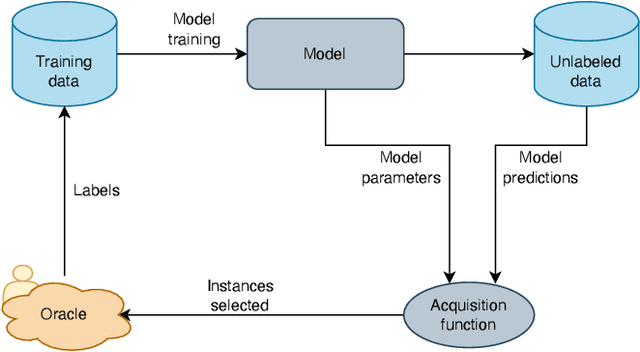
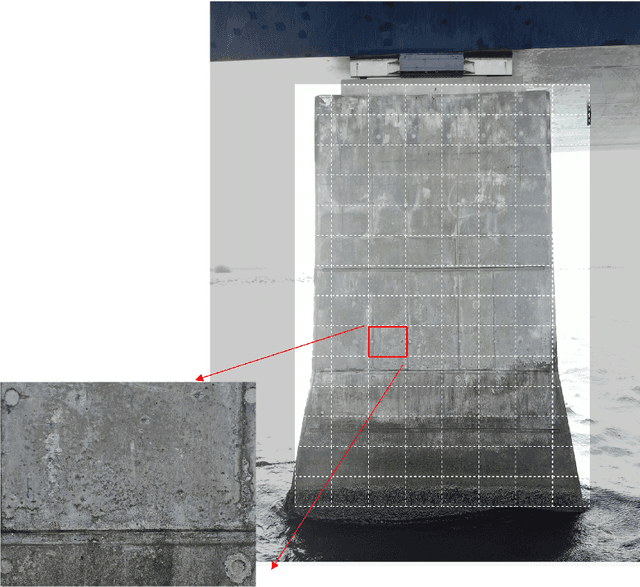
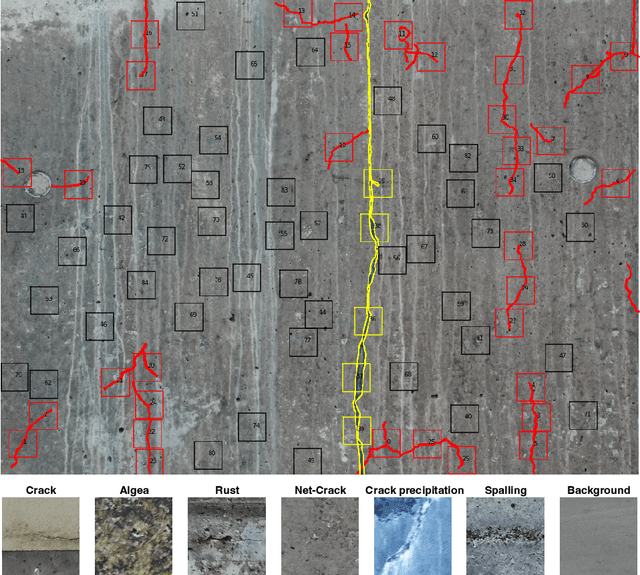
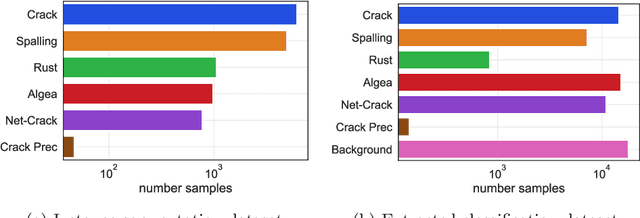
Abstract:Aging civil infrastructures are closely monitored by engineers for damage and critical defects. As the manual inspection of such large structures is costly and time-consuming, we are working towards fully automating the visual inspections to support the prioritization of maintenance activities. To that end we combine recent advances in drone technology and deep learning. Unfortunately, annotation costs are incredibly high as our proprietary civil engineering dataset must be annotated by highly trained engineers. Active learning is, therefore, a valuable tool to optimize the trade-off between model performance and annotation costs. Our use-case differs from the classical active learning setting as our dataset suffers from heavy class imbalance and consists of a much larger already labeled data pool than other active learning research. We present a novel method capable of operating in this challenging setting by replacing the traditional active learning acquisition function with an auxiliary binary discriminator. We experimentally show that our novel method outperforms the best-performing traditional active learning method (BALD) by 5% and 38% accuracy on CIFAR-10 and our proprietary dataset respectively.
Model-Assisted Labeling via Explainability for Visual Inspection of Civil Infrastructures
Sep 22, 2022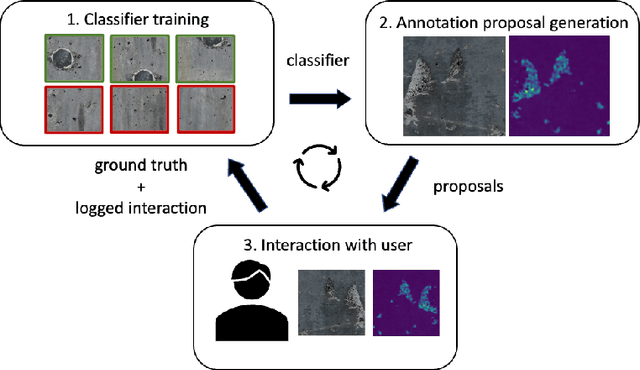
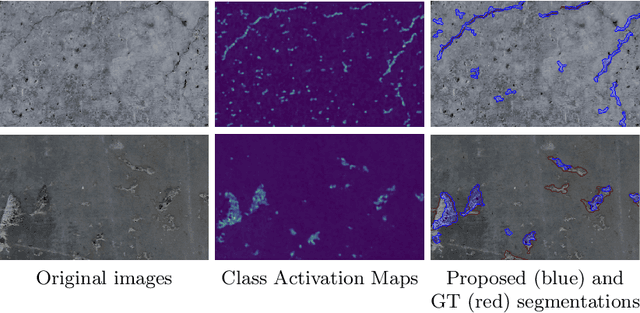

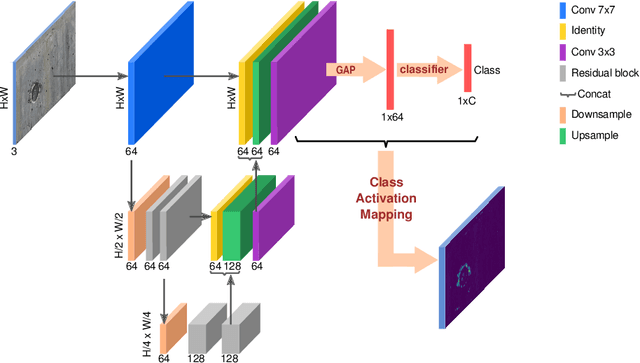
Abstract:Labeling images for visual segmentation is a time-consuming task which can be costly, particularly in application domains where labels have to be provided by specialized expert annotators, such as civil engineering. In this paper, we propose to use attribution methods to harness the valuable interactions between expert annotators and the data to be annotated in the case of defect segmentation for visual inspection of civil infrastructures. Concretely, a classifier is trained to detect defects and coupled with an attribution-based method and adversarial climbing to generate and refine segmentation masks corresponding to the classification outputs. These are used within an assisted labeling framework where the annotators can interact with them as proposal segmentation masks by deciding to accept, reject or modify them, and interactions are logged as weak labels to further refine the classifier. Applied on a real-world dataset resulting from the automated visual inspection of bridges, our proposed method is able to save more than 50\% of annotators' time when compared to manual annotation of defects.
Cloud-Based Real-Time Molecular Screening Platform with MolFormer
Aug 13, 2022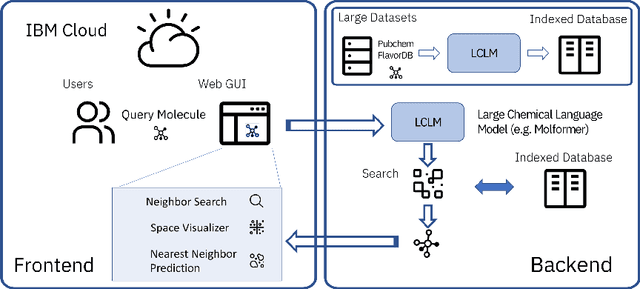
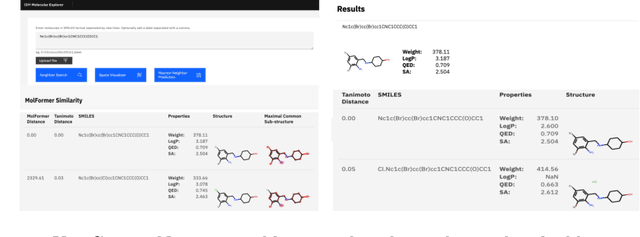
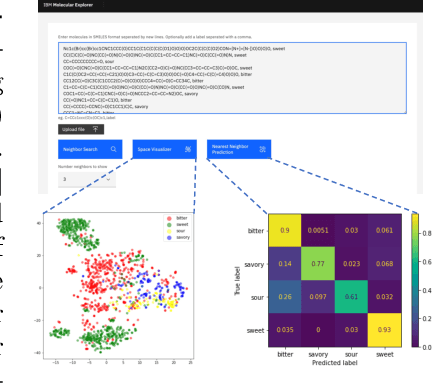
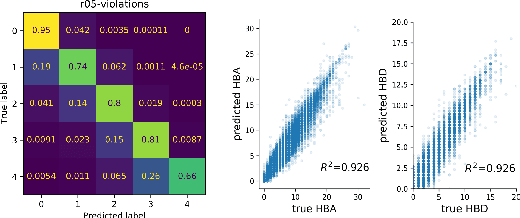
Abstract:With the prospect of automating a number of chemical tasks with high fidelity, chemical language processing models are emerging at a rapid speed. Here, we present a cloud-based real-time platform that allows users to virtually screen molecules of interest. For this purpose, molecular embeddings inferred from a recently proposed large chemical language model, named MolFormer, are leveraged. The platform currently supports three tasks: nearest neighbor retrieval, chemical space visualization, and property prediction. Based on the functionalities of this platform and results obtained, we believe that such a platform can play a pivotal role in automating chemistry and chemical engineering research, as well as assist in drug discovery and material design tasks. A demo of our platform is provided at \url{www.ibm.biz/molecular_demo}.
Deep Bandits Show-Off: Simple and Efficient Exploration with Deep Networks
May 10, 2021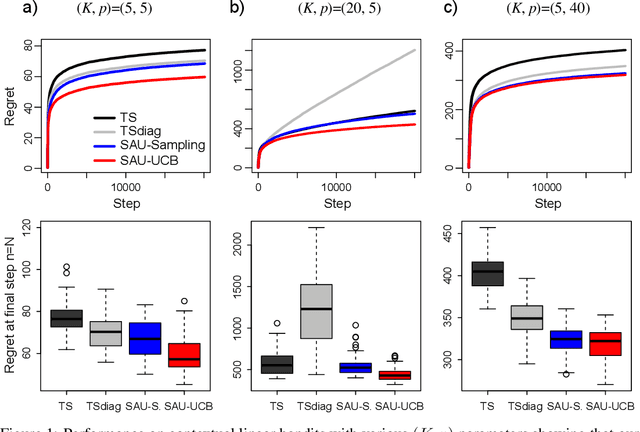

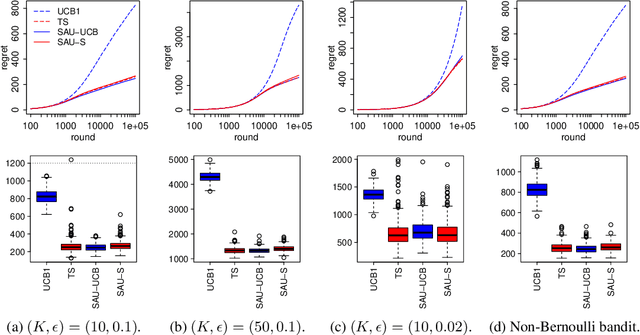

Abstract:Designing efficient exploration is central to Reinforcement Learning due to the fundamental problem posed by the exploration-exploitation dilemma. Bayesian exploration strategies like Thompson Sampling resolve this trade-off in a principled way by modeling and updating the distribution of the parameters of the the action-value function, the outcome model of the environment. However, this technique becomes infeasible for complex environments due to the difficulty of representing and updating probability distributions over parameters of outcome models of corresponding complexity. Moreover, the approximation techniques introduced to mitigate this issue typically result in poor exploration-exploitation trade-offs, as observed in the case of deep neural network models with approximate posterior methods that have been shown to underperform in the deep bandit scenario. In this paper we introduce Sample Average Uncertainty (SAU), a simple and efficient uncertainty measure for contextual bandits. While Bayesian approaches like Thompson Sampling estimate outcomes uncertainty indirectly by first quantifying the variability over the parameters of the outcome model, SAU is a frequentist approach that directly estimates the uncertainty of the outcomes based on the value predictions. Importantly, we show theoretically that the uncertainty measure estimated by SAU asymptotically matches the uncertainty provided by Thompson Sampling, as well as its regret bounds. Because of its simplicity SAU can be seamlessly applied to deep contextual bandits as a very scalable drop-in replacement for epsilon-greedy exploration. Finally, we empirically confirm our theory by showing that SAU-based exploration outperforms current state-of-the-art deep Bayesian bandit methods on several real-world datasets at modest computation cost.
Image Captioning as an Assistive Technology: Lessons Learned from VizWiz 2020 Challenge
Dec 21, 2020
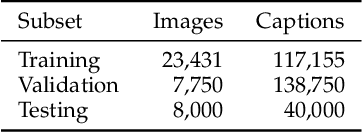

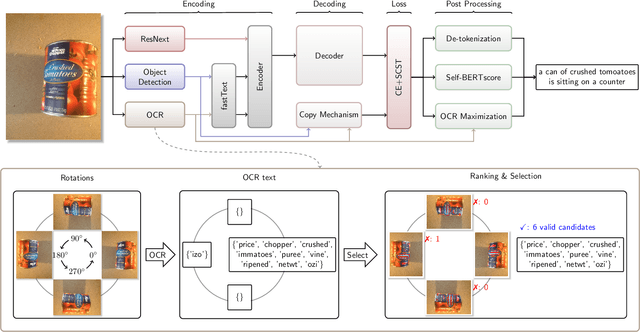
Abstract:Image captioning has recently demonstrated impressive progress largely owing to the introduction of neural network algorithms trained on curated dataset like MS-COCO. Often work in this field is motivated by the promise of deployment of captioning systems in practical applications. However, the scarcity of data and contexts in many competition datasets renders the utility of systems trained on these datasets limited as an assistive technology in real-world settings, such as helping visually impaired people navigate and accomplish everyday tasks. This gap motivated the introduction of the novel VizWiz dataset, which consists of images taken by the visually impaired and captions that have useful, task-oriented information. In an attempt to help the machine learning computer vision field realize its promise of producing technologies that have positive social impact, the curators of the VizWiz dataset host several competitions, including one for image captioning. This work details the theory and engineering from our winning submission to the 2020 captioning competition. Our work provides a step towards improved assistive image captioning systems.
 Add to Chrome
Add to Chrome Add to Firefox
Add to Firefox Add to Edge
Add to Edge